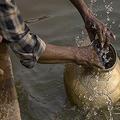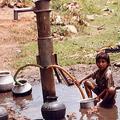 曾經擔任印度商業及環境新聞線記者的雅各(Nitya Jacob,以下簡稱NJ),近來接下了一件獨特的任務,亦即針對印度河流域的水資源情況撰寫一本生態遊記。
曾經擔任印度商業及環境新聞線記者的雅各(Nitya Jacob,以下簡稱NJ),近來接下了一件獨特的任務,亦即針對印度河流域的水資源情況撰寫一本生態遊記。
雅各以德里做為記錄的主要基礎,其研究結果相當具衝擊性。在寫完以水為主題的書之後,雅各表示,儘管印度目前擁有過剩的水源,以及全球水源管理的豐富經驗,但印度所面臨的水源危機已相當嚴重。
雅各新書書名為「探索印度傳統水源管理機制」,書中他觀察到,5000年薪火相傳的知識價值,讓印度在近代成為全球富有的國家之一,但這些知識已逐漸被淡忘,而這也是導致危機的主要原因之一。
以下是記者專訪雅各的問答內容:
記者諾羅哈(Frederick Noronha,以下簡稱FN):你會如何形容這本書?
NJ:這本書主要從環境及社會背景來探討水資源,並點出水源管理的發展主要是考量當地形勢,以最便利的方法提供當地居民水源。
FN:書中最令人感到驚訝的發現?
NJ:第一,從水源管理的工程型態中看出水源知識的多樣性;第二,古人建構水利工程知識的深奧;第三,了解到水能載舟亦能覆舟的道理。
 FN:過程中什麼是你認為最重要的課題?
FN:過程中什麼是你認為最重要的課題?
FJ:我們必須尊重水資源,而不是把它視為日用品或是可以購買的商品,我們這樣的行為已持續太久,而我們的思想也被西化的教育體制所定型,那些沒有受過教育的農民,比工程師更懂的這個道理。
由於同時具備環境和技術的特點,使得水源管理成為社會文化性的議題,但在現代解決方案中常常忽略了這點。控管水源使用的社會結構和社會機制,應盡可能的被納入現代工業方案考量中,不符合社會需求的技術應該被捨棄。
FN:你會如何形容目前印度的水源現況?
NJ:我們正處在自己造成的危機之中,但情況還沒有失控,我們擁有豐沛的水源,但人民已放棄監督政府管理水資源的角色。
農民過度灌溉因為沒有人告訴他們需要使用多少水量來取得最好的生產效益,我所接觸過的農民中,沒有人知道灌溉實際需要的水量,因為所有的相關農業技術人員,或是販賣種子和設備的推銷人員,只告訴他們需要多少設備和殺蟲劑,而不是水量。
 FN:就你個人來看,印度在水源上所面臨的最大挑戰是什麼?
FN:就你個人來看,印度在水源上所面臨的最大挑戰是什麼?
NJ:水資源管理、天然和人為所造成的污染、降雨量改變引發水量的落差、地表儲水量的減少,以及多處河段被接通水管等等。
Former business and environmental journalist Nitya Jacob has undertaken an unusual task - an ecological travelogue across the Indian subcontinent focused on water.
The Delhi-based writer's findings are stark. After writing a book on the subject, he says that in spite of surplus water, and one of the world's richest traditions of managing it, India's water crisis has reached critical levels.
Jacob's new book is called "Jalyatra: Exploring India's Traditional Water Management Systems." In it he observes, "The 5,000 years worth of traditional knowledge which made India one of the richest countries in the not-too-distant past has been forgotten and is one of the main reasons behind the crisis."
FN: How would you describe the book?
NJ: This book places water resources in the local environmental and social context. It does so to make the case that water management evolved in keeping with local conditions to serve local populations.
FN: What was the three most surprising finds from the book?
NJ: Firstly, the sheer diversity of water wisdom as reflected in the types of water management structures. Secondly, the depth of knowledge that the ancients had about constructing water structures. Thirdly, the extent to which water was respected as the giver and destroyer of life are the three most surprising finds from the book.
FN: What do you see as the major lessons that emerge?
NJ: We have to respect water and not treat it as a commodity or something to be merely consumed. We have done this for too long, and our thinking has been shaped by a Westernized education system. Those 'ignorant peasants' know more about this than most engineers today.
Water management is as much a social-cultural issue as it is an environmental and technical one. But this has always been ignored in modern solutions. As far as possible, social structures and mechanisms that governed water resource use have to be mapped onto modern technical solutions and technology that does not fit social needs has to go.
FN: How would you describe the water situation in India today?
NJ: We are in a crisis of our own making but things haven't gone out of control yet. We have plenty of water, but people have abdicated their role in looking after these resources to the government.
Farmers over-irrigate because nobody has told them how much water is really needed to optimize food production. None of the farmers I spoke to had any idea how much water is actually needed because all farm extension workers or seed and fertilizer sellers tell them is the amount of fertilizer and pesticides needed, not water.
FN: What are the biggest challenges on the water front that India currently faces in your view?
NJ: Mismanagement of water resources, pollution from natural and manmade sources, and increasing disparities in availability due to changing rainfall, and shrinking surface storage and rivers being tapped at various points.
全文及圖片詳見:ENS




